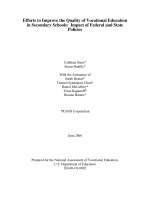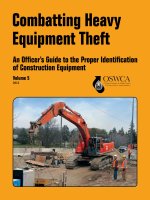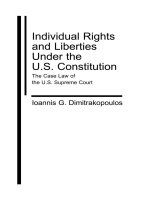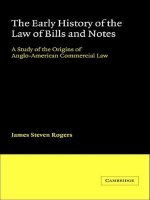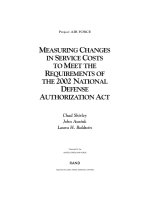Note to module planner law of tort
Bạn đang xem bản rút gọn của tài liệu. Xem và tải ngay bản đầy đủ của tài liệu tại đây (1.43 MB, 71 trang )
How to use the Module Planner
General
The Module Planner has been divided into a number of ‘Units,’ which you will progress
through (more-or-less) in order, and which represent an attempt to divide up Law of Tort
in a reasonably intellectually coherent fashion.
This Module Planner sets out in detail the plan of work for your module. Your classes will
be structured around it, and your seminars are likely to be based upon the materials to
be found here. Each Unit has an Introduction to set the scene, and references to show
you what to read. Your lecture tutor is likely to follow the Planner’s order of topics, and
your seminar tutor to set you a number of questions to prepare ahead of each next
week’s class.
Lectures
For lectures, make sure you know what the topic is going to be in advance, and reflect
upon how what you know already relates to that. If you have the opportunity to read
ahead on the substance of the lecture, so much the better. Bring your Planner to the
lecture, so that you can check the issues and names of the cases as your lecturer refers
to them. That will guide you in how much more you need to read ahead of the seminar.
Seminars
The three elements of your pre-seminar reading are the cases (and statutes where
applicable), any articles that catch your attention, and your chosen main textbook. Which
order you read them in seems a matter of choice. The writer’s preference is the order
just stated, which has the bonus that if the cases are read on Westlaw then the database
itself will make some suggestions of its own for articles to read.
You will then need to work at the seminar questions. Outline answers will usually suffice,
but you should feel free to offer your tutor more fully written-up answers from time to
time for them to give you feedback. Most will be happy to do this, since they know that
only by practice will you get to a point where you can be confident of passing. A low
mark now is better than a low mark in the coursework or examination. You should bring
at least a textbook to your seminar in order to check or look up novel points as they
arise.
Reading for Class
The cases are there to be read, not to show off the writer’s learning. Although the
general answer to ‘Which are the most important cases?’ is ‘All of them’,
nevertheless it is sometimes possible to mark particular cases as the ones that are to be
read first. If you ‘do not have time to read the cases’ then you do not have time to
pass the assessments – it is as simple and brutal as that. The statutes listed are a
matter of finding the relevant sections and becoming familiar with them: the writer’s
advice is to print them off from Westlaw or follow the links from the House of
Parliament’s website: www.parliament.uk.
Self-Test Questions
There are then the Self-Test questions, designed to take you (most of) the way
through each Unit by showing you the issues with which you need confidently to be able
to grapple before attempting the Seminar Questions. Make sure that you can answer
these before proceeding to the Seminar Questions.
Seminar Questions
Your tutor is likely to designate a few Questions for you to concentrate upon each
week: your final preparation should therefore focus upon those. The Questions show the
sorts of questions on each topic that get asked in assessments, especially examinations.
You may therefore gauge from week to week your likely examination performance by
how much you are able to contribute to the discussion in seminars. Of course, if that
doesn’t amount to very much... – then you may wish to discuss that with your tutor. You
will be surprised by how willing to help you they are.
It should be stressed at the outset that all names used in Questions (of any kind),
Assessments and Written Assignments are hypothetical, and all incidents imaginary, and
that no resemblance to any person or being, living or dead, real or imaginary, is intended
or should be inferred. All inappropriate similarities, whether of name or of incident or
both, are coincidental.
Contents
The Law of Tort – A Brief Introduction
1
Module Descriptor
2
Study Advice
9
Plagiarism
10
Study Unit One
Introduction to the Law of Torts
11
Study Unit Two
The Standard of Duty of Care
14
Study Unit Three
Causation
18
Study Unit Four
Product Liability and the Consumer Protection Act 1987
23
Study Unit Five
Psychiatric Injury
26
Study Unit Six
Economic Loss caused by Negligent Misstatement
30
Study Unit Seven
Common Law Employer’s Duties towards Employees
34
Study Unit Eight
Vicarious Liability
36
Study Unit Nine
Defences in Negligence
40
Study Unit Ten
Occupiers Liability
44
Study Unit Eleven
Private Nuisance
47
Study Unit Twelve
The Rule in Ryland v Fletcher
51
Study Unit Thirteen
Defamation
54
Study Unit Fourteen
Trespass to Persons/Unlawful Interference with Goods
58
Assessment
61
Revision and Examination Techniques
63
The Law of Tort – A Brief Introduction
A tort is a civil wrong which entitles a person who suffers a detriment by its commission
to claim damages for his loss or injury. In some circumstances, such as where a person
suffers from a nuisance, the most appropriate remedy will be an injunction to prevent the
continuation of the nuisance. The primary function of the law of tort is to compensate the
victim of a civil wrong, but the law also acts as a deterrent.
Tort distinguished from Crime and Contract
The duty to refrain from committing a tort is imposed upon us all by law whether we like
it or not and that duty is owed to everybody. In contract any liability can only come into
existence by the agreement of the parties concerned. A tort differs from a crime in that a
crime is not a civil wrong. The object of criminal proceedings is to protect the community
as a whole, whereas the principal objective of tort is to compensate a claimant for his
loss. A crime is punishable by the state whereas a claim in tort is brought by the person
who has suffered a detriment – the claimant.
A tort may also be a crime – so for example, any person who drives his car is obliged by
law to drive carefully so as not to injure any other road user. In the event that a driver
breaches his duty and is negligent in his driving any person who suffers as a result of his
negligence may bring a claim against the driver of the vehicle. The negligent driving may
also be a crime such as driving without due care and attention – this will be punishable
by the state. It can be seen therefore that a person who drives negligently causing an
accident may be punished by the state and may face a civil claim from any person who
has suffered as a result of his negligence.
Interests Protected
There are many different distinct torts which protect a wide range of interests. A person’s
personal safety is protected by the torts of negligence, battery, assault and false
imprisonment. Personal property is protected by the torts of nuisance, trespass to goods
and trespass to land. A person’s personal reputation is protected by the tort of
defamation. These interests are protected by means of the law acting as a deterrent and
by providing a mechanism for claiming compensation in the event of a breach.
1
Defences to an Action in Tort
There are two types of defences that may be raised to an action in tort – those which
may be raised in respect of more than one tort are known as general defences and
include contributory negligence, volenti non fit injuria (assumption of risk or consent),
self-defence, necessity and Act of God. Other defences such as the defence of qualified
privilege in libel are only available in respect of one tort and are known as particular
defences.
Module Descriptor
Module Title:
Law of Tort – WLLW2006
Pre-Requisites:
None
Level of Study:
Level 5
Total Learning Hours:
300 hours
Credits:
30
Teaching Method:
Lectures and Seminars (in term-time). The teaching element of
the module will be delivered by means of two one-hour lectures
(often delivered consecutively) and one one-hour seminar each
week. The lectures will set out the rules principles and caselaw
concerning each topic, making particular reference to any
especially problematic areas. Seminars will develop, test and
challenge students’ understanding of each topic and ability to
apply it under assessment conditions. As well as their unit-byunit research and reading, students will be expected to prepare
specific discursive and problem-solving questions for discussion
in class. Extensive use will be made of formative assessment
techniques.
Core Module:
2
Yes
Learning Outcomes for the Module
Knowledge
On completion of the module you will:
1.
Identify and compare the nature of tort liability in comparison with contractual and
criminal liability.
2.
Explain the essential elements of the tort of negligence, namely the duty of care,
the standard of duty of care to needed to be discharged depending on the skill of
the actor and the significance of policy considerations.
3.
Explore issues of causation in law and remoteness in negligence.
4.
Explore particular areas of negligence such as medical causation, psychiatric
harm and economic loss which involve the application of specific rules.
5.
Explain the general defences in tort and also the rules relating to the assessment
of damages.
6.
Explain and apply the law relating to occupiers’ liability.
7.
Explain the doctrine of strict liability in tort as stated in the case of Rylands v
Fletcher, together with any defences that are available.
8.
Explain the law of defamation and apply the common law and statutory defences
available as well as the remedies available to a claimant.
9.
Explain the law of trespass to persons and property and evaluate the differences
between it and the law of negligence.
10.
Explain the criteria that is needed to satisfy private nuisances and any defences
that are available.
11.
Explain the main provisions of the Consumer Protection Act 1987 and the cases
based on this statute.
Skills
On completion of the module the student will be able to:
12.
Identify and explain key legal concepts in the law of tort and apply them to case
studies.
13.
3
Analyse and synthesise relevant knowledge of law to complex legal issues.
14.
Demonstrate a high degree of problem solving abilities, including the ability to
identify the relevant issues and propose different solutions to factual cases.
15.
Research both primary and secondary sources to evaluate key legal principles.
16.
Demonstrate clear and effective written communication of arguments given a
specified word limit or under timed examination conditions.
17.
Demonstrate the ability to work independently and in a team.
18.
Present clear and succinct oral arguments based on case studies.
Assessment Criteria
In Law of Tort, as a Level Five module, the particular assessment criteria used to assess
the knowledge, research skills, analysis, application, and communication skills in the
Learning Outcomes for this module are that the student will be required to:
1.
demonstrate a critical understanding of the main principles of Law of Tort and
their inter-relationship and development;
2.
understand, interpret, analyse and discuss with clarity legal materials relating to
the Law of Tort;
3.
identify issues relating to a given problem, apply legal rules and principles and
propose solutions, including a critical evaluation of the appropriateness of
different problem-solving methods;
4.
carry out research according to a selection of the main Law of Tort methods of
inquiry, showing an awareness of the limits of knowledge and issues of
interpretation and produce a comprehensive analysis of the current state of the
law in a given area of the Law of Tort;
5.
retrieve up-to-date primary and secondary sources of legal information, use legal
terminology with accuracy, analyse primary legal materials and communicate
effectively in the English language;
6.
demonstrate the ability to work independently and as part of a group.
Assessment Strategy
There will be three units of Assessment for the module, which will assess the Learning
Outcomes according to the above Assessment Criteria as follows:
20%
Team Oral Presentation
You will be required to work in pairs and carry out
research on a hypothetical case study and present
the issues and their solutions as opposing parties
to the dispute. This will assess Learning Outcomes
1-10, 12-15 and 17 & 18.
70% of the overall mark will be given towards the oral presentation. 20% will be
allocated for the skeleton argument (500 words maximum). The final 10% will be for the
bibliography.
4
30%
Coursework
50%
Examination
You will research a pre-advised general area and
then answer an unseen question under timed
conditions (one hour) This will assess Learning
Outcomes 1-5 and 12-16.
This will be a 2 hours 15 minutes unseen
examination (with reading time), consisting of short
answer questions based on a case study (Section
A). This will assess Learning Outcomes 1-11 and
12-16.
Reading List
Paul Giliker and Silas Beckwith, Tort, 3rd Edition 2008 (Sweet & Maxwell)
You are strongly recommended to read this text book as we will be using it as the ‘core’
text book for this module. You will be asked to read the relevant chapters at the start of
each module.
To accompany the above text book, you should also purchase Tort: Cases and
Materials, Second Addition (Sweet and Maxwell) by Geoffrey Samuel
The following text and case books are also recommended:
Jenny Steele, Tort Law, Text, Cases and Materials, 1st Edition, Oxford University
Winfield and Jolowicz on Tort, Rogers (17th edition) 2006 (Sweet & Maxwell)
Markensis and Deakin, Tort Law, 6th Edition, 2007 (OUP)
Law Reports
Students are liable to ask ‘Do I have to read all these cases?’ The short answer is ‘Yes.’
Not for nothing is this known as a common law legal system. The longer answer is that
these are merely a selection – although it is intended to be a representative one that
covers the main points on each topic – and that the better question is ‘Can I pass
despite reading so few as these?’ The answer to that question may well be ‘Yes’, but
you will need to read the Law Reports thoroughly and reflect upon what you read. At any
rate, it is on that basis that these lists were compiled.
It is assumed that the reader is familiar by now with the various sets of Reports, and
where to find them in the Library. They will find that many important Tort cases are also
available online, and that will be especially useful to them at coursework time.
5
Websites
Increasingly the internet is becoming a good source of information for law students. The
following may be of use, but bear in mind that URLs are subject to change, as is the free
access provided by some operators.
(A) LAW REPORTS
www.the-times.co.uk/news
This site has a searchable database going back to 1 January 1996. Law reports can be
accessed for printing or downloading to disk.
http;//www.parliament.thestationeryoffice.co.uk/pa/ld199697/ldjudgemt.htm
Excellent free site containing full text of recent House of Lords’ decisions – fully
downloadable to print or disk.
http;//www.smithbernal.com/casbase
Currently provides free transcripts of recent English cases – very useful.
www.lawreports.co.uk
This is the official law report site – has special student pages with case summaries. Also
has 24 hour updated legal news pages – day by day decision reports.
http//www.courtservice.gov.uk/lexicon
Court Service homepage – has limited number of appeal case transcripts.
www.swarb.co.uk-negligence
Links to UK cases on negligence
www.swarb.co.uk-other
Links to general tort cases.
(B) PARLIAMENT
www.parlchan.co.uk/index.htm
Quick reference guide to the House of Commons and its business.
www.parliament.uk
Gateway site for both the House of Commons and the House of Lords.
6
(C) LEGAL REFERRAL SITES
www.venable.co.uk
Excellent free general resource site – provides a gateway to a host of other web
resources related to law.
http;//www.ukc.ac.uk/library/lawlinks/default.htm
Currently one of the best gateway sites in the UK, maintained by the University of Kent.
Numerous useful links.
www.legal.net
Gateway site to huge database of USA law – useful for comparative research. Very
comprehensive US searchable database – great for comparative studies.
www.westlaw.com
Excellent summaries of cases on all subjects.
(D) PUBLISHERS
www.cavendishpublishing.com
Lots of useful information for students and good links – regular case updates and a
virtual classroom.
www.butterworth.co.uk
Site for Butterworths the leading legal publishers – allows free access to a recent
developments archive that is useful for quick reference – fully downloadable to print or
disk.
www.smlawpub.co.uk
Site for Sweet & Maxwell, leading law publishers.
(E) GOVERNMENT SITES
www.hmso.gov.uk/stat.htm
Very useful site providing full text of recent Acts of Parliament and some delegated
legislation. Fully downloadable to print or disk.
www.open.gov.uk/law.comm/homepage.htm
Site allows access to full text of Law Commission consultation papers and reports.
7
Journals
Various articles are cited for you to read in each Unit, and the use of Westlaw for your
case reading will automatically lead you towards others. What you have below are some
of the major standard abbreviations used in referencing them. So far as possible, journal
citations have been restricted to those that are readily available, either in hard copy or
electronically.
A large number of journal articles are cited, so it is worth making clear what is expected.
You are expected (indeed, required) to read every single case cited (see above).
You are not expected to read every journal article – indeed, you are expected not to do
so. Instead, read those that seem most relevant to what you are assigned particularly by
your tutor to work on, or seem most interesting from their title, and so on.
Please bear in mind that articles are only secondary sources, whereas the caselaw is
the primary source of English [and Welsh, as always] Law. However, they will deepen
your understanding of the subject, which will be especially relevant to those seeking or
needing to obtain the higher grades in this module.
Some of the less well-known sets of Law Reports are also listed here, since they will
sometimes be cited in the Units that follow.
CLJ Cambridge Law Journal
CLP Current Legal Problems
IHL In-House Lawyer
L Ex Legal Executive
L Teach Law Teacher Journal
Legal Studies Legal Studies
LQR Law Quarterly Review
MLR Modern Law Review
NLJ New Law Journal
8
Learning Outcomes
Each unit contains a number of learning outcomes: these are intended as a formal
statement of its contents in order to guide you in your study of each topic. Once you
have completed the reading for each unit, you should go back to the learning outcomes
and ensure that you understand the topics to which they refer. Remember that the
subject must always be looked at as a whole: if you do not understand what the learning
outcomes refer to, you will need to repeat your reading.
You should not progress from one unit to the next until you understand, and have
reached, the learning outcomes for that particular unit. You will be able to tell whether
you have done so from your answers to the questions in the unit.
Study Advice
One of the main areas of study in tort is negligence. You will see that almost one third of
the syllabus is devoted to this one particular tort. Other torts that will be studied include
occupiers’ liability, nuisance, defamation, liability for animals, trespass to the person,
goods and land and vicarious liability.
The law of tort is heavily case based and students are advised to make case notes from
the outset – the same cases will be used to illustrate several legal principles and the
making of case notes will help to save time and help in understanding a course which is
conceptually challenging at times, but is generally thoroughly enjoyed by the vast
majority of students.
9
Plagiarism
Plagiarism is a form of dishonesty which is viewed by the College and the University as
a serious offence. The University’s Regulations contain provisions by which the
Examination Board may penalise students who are found to have presented plagiarised
work for assessment. The purpose of this statement is to explain what plagiarism is.
Further information about the procedures which are followed, where allegations of
plagiarism are made - together with the penalties that may be imposed - can be found in
the University of Wales Regulations, and the Programme Handbook.
Plagiarism consists of presenting someone else’s work as your own. Some examples of
plagiarism are:
•
reproducing or paraphrasing published material without acknowledgement of the
source
•
copying from the work of another student
•
undeclared collusion with another student
•
getting someone else to do your work for you
This is not an exhaustive list. There are clearly degrees of plagiarism, particularly where
published work is concerned. At one extreme there may be a very short section of a
coursework which is copied without being properly referenced; at the other extreme a
coursework may consist almost entirely of copied work.
10
Study Unit One
Suggested minimum study hours: 3 hours
Topic
Introduction to the law of Torts
Learning Outcomes
•
Explain the meaning of '
tort’;
•
Explain the meaning of ‘negligence;’
•
Explain the key differences between tort and criminal liability;
•
Demonstrate awareness of Lord Atkin’s neighbourhood principle;
•
Discuss the nature of acts and omissions in regards to duty of care and the
circumstances which give rise to it;
•
Explain the development of the neighbourhood principle in Anns v Merton and the
three stage test in Caparo v Dickman.
Essential Reading
Chapter 1 (Page 1 to 20), Tort, Giliker and Beckwith, 3rd Edition
Chapter 2 (Page 21 to 42 only), Tort, Giliker and Beckwith, 3rd Edition
Other Reading
Rodger ‘Lord MacMillan’s Speech in Donoghue v Stevenson’ (1992) 108 LQR 236
Markesinis and Deakin ‘An Analysis of the Tort of Negligence from Anns to Murphy’
(1992) 55 MLR 619
Primary Sources
Neighbourhood principle
Donoghue v Stevenson [1932] A.C. 562
Bourhill v Young [1943] AC 92
Development of the principle of Duty of Care and the ‘Two Stage Test’
Dutton v Bognor Regis UDC [1972] 1 QB 373
Anns v Merton London Borough Council [1978] AC 728
11
Junior Brooks v Veitchi [1983] 1.A.C. 520
Sutherland Shire Council v Heyman (1985) 60 ALR
Yuen Kun Yeu v Attorney General of Hong Kong [1988]
Murphy v Brentwood District Council [1991] AC 398
The Three Stage Test
Caparo Industries v Dickman [1990] 2 AC 605
Absence of duty
Smith v Littlewoods Organisation Ltd [1987] 2.WL.R. 480, HL
Self-Test Questions
1.
What was the significance of the judgment of Lord Atkin in Donoghue v
Stevenson?
2.
How did Lord Atkin formulate the test for the existence of a duty of care? Who in
law is my neighbour?
3.
How was the principle in Donoghue v Stevenson applied in Home Office v Dorset
Yacht Co?
4.
What was the two-stage test enunciated by Lord Wilberforce in Anns v Merton
London Borough Council?
5.
What did Lord Wilberforce mean by proximity? What is the ‘necessary
qualification of proximate relationship’?
6.
What was the formulation of the test for duty of care in Caparo v Dickman?
7.
There now appear to be four requirements for establishing whether a duty of care
exists: forseeability of damage, proximity, public policy and whether it is just and
reasonable to impose a duty. Will all these requirements be referred to by the
court in every case?
8.
In determining what is fair, just and reasonable, what factors will the court take
into account?
12
Seminar Questions
1.
2.
Analyse the fundamental differences between the law of Tort and
1)
Criminal Law
2)
Contract Law
Taken from A Casebook on Tort by Tony Weir Sweet & Maxwell, 10th Edition.
a)
Suppose that Mrs Donoghue bought a bottle of Stevenson'
s ginger beer
for 40p and took it home; and that when she opened it, she saw a
decomposed snail at the top of the bottle, and suffered shock at the
thought
of what she might have drunk. Could she recover from the
manufacturer (i) damages for shock; (ii) 40p?
b)
Suppose that Stevenson got his bottles from Louis, and that Mrs
Donoghue had been injured because of a defect in the bottle which
Stevenson couldn'
t have discovered. Would Louis or Stevenson be liable,
or both?
c)
Suppose that the victim is not a regular consumer like Mrs Donoghue but
a shop-lifter or a tester for "Which?"* Would you make the manufacturer
liable? If not, would this be because he owed no duty or for some other
reason?
* ‘Which’ is a consumer watchdog magazine
3.
John is a window cleaner and has agreed to clean the windows of Samantha’s
house.
Explain whether a duty of care arises in the following situations:
a)
During lunch time, John decides to go to the café for something to eat. He
leaves the ladder underneath the window to Samantha’s house. A burglar
climbs up the ladder and steals jewellery and money from Samantha’s
bedroom.
b)
John needs to go the toilet and leaves the ladder lying on the floor. A
burglar steels the ladder and uses it to break into a window of a house a
few blocks away.
c)
John leaves the ladder alongside the door of Samantha’s house to
answer a telephone call on his mobile. Samantha’s son, Peter climbs up
the ladder and slips. He lands on his elbow and requires hospital
treatment.
13
Study Unit Two
Suggested minimum study hours: 3 hours
Topic
The Standard of Duty of Care
Learning Outcomes
•
Explain the key factors surrounding the general standard of duty of care including
foreseeability and magnitude of risk, the activity in question and steps taken to
reduce risk;
•
Research the key provisions of the Compensation Act 2006 in relation to the
standard of duty of care and evaluate its significance;
•
Identify the standard of duty of care for professionals and amateurs and analyse
policy issues involved in case law decisions;
•
Demonstrate awareness of the concept of causation;
•
Briefly identify the difference between causation in ‘fact’ and in ‘law’;
•
Explain the concept of Res Ipsa Loquitur.
Essential Reading
Chapter 5 (Page 140 to 166), Tort, Giliker and Beckwith, 3rd Edition
Chapter 11 (11-018 – 11.033) (Page 356 to 372), Tort, Giliker and Beckwith, 3rd Edition (
Consent to Treatment )
Other Reading
Primary Sources
General Standard of Duty of Care
Blyth v Birmingham Waterworks Co (1856)
Roe v Ministry of Health [1954] 2 Q.B. 66
Amateurs
Wells v Cooper [1958] 2 QB 265
Nettleship v Weston [1971] 2 QB 69
14
Standard of duty of care for professionals
Bolam v Friern Hospital Management Committee [1957] 1 WLR 582
Whitehouse v Jordan [1980] All E.R. 650
Wilsher v Essex Area Health Authority [1988] AC 1074
Is the Duty of Care Absolute?
Latimer v AEC [1953] AC 643
General Cleaning Contractors v Christmas [1953] AC 180
What steps need to be taken to eliminate risk?
Bolton v Stone [1951] AC 850
Paris v Stepney Borough Council [1951] AC 367
Res ipsa loquitur
Byrne v Boadle [1863] 2 H&C 722.
Cassidy v Ministry of Health [1951] 2 KB 343
Henderson v Henry E Jenkins & Sons [1970] AC 282
Ward v Tesco Stores Ltd [1976] 1 WLR 810.
Ng Chun Pui v Lee Chen Tat [1988] RTR 298
Self-Test Questions
1.
How was negligence defined in Blyth v Birmingham Waterworks Co? What is the
objective test?
2.
Why is the standard of the reasonable man used? What are the characteristics of
a reasonable man?
3.
How was the standard of the reasonable man applied in Nettleship v Weston?
4.
What does Bolton v Stone state about the foreseeability of risks? At what point
should the cost justify the reasonable man in taking no precautions?
5.
What is the standard of care demanded of a child?
6.
Is the standard of care required reduced in the case of an emergency?
7.
What standard is used for skilled or professional persons?
8.
Is there a distinction between negligence and an ‘error of clinical judgment’?
9.
Explain what is meant by the term res ipsa loquitur?
15
Seminar Questions
1.
Billy is an aged, accident-prone, golf-loving millionaire. He owns a large estate on
the outskirts of Preston on which he has built a golf course.
Billy has been blessed with the ability to hit a golf-ball very hard but,
unfortunately, lacks the ability to direct his shots. Occasionally he hits the ball out
of his estate on to a busy street in Preston.
When this happens the ball is usually travelling very fast and should it hit anyone
it is likely to occasion serious injury. Billy could largely reduce the risk of injury by
erecting a 20-foot fence around his estate, at a cost of £80,000, but is unwilling to
do so because it would lower the appearance of his estate.
One day a ball hit by Billy goes out of his estate and hits Jimmy, severely injuring
him.
Advise Billy as to whether or not he has been negligent.
2.
In 1996 Brenda, then aged 20, had recently started a modelling career. She went
to Andrew, a dentist, complaining of intermittent severe pain in her jaw. Andrew
treated an infected tooth. She did not experience the pain for some time but early
in 1998 it recurred more severely. Tests have shown that she is suffering from a
cancerous condition and will require major surgery which will leave her
disfigured. The medical evidence now is that early signs of her condition would
normally have been detectable as early as 1995 and that there is a possibility
that, if she had been treated in 1996,she would have experienced no
disfigurement.
Last month she was walking past a lorry belonging to Conrad plc which was
parked in the street. A heavy sack suddenly toppled from the lorry for no
apparent reason and struck her in the face. She was permanently scarred and
lost an eye.
Advise Brenda.
3.
Mrs White was admitted to hospital with breathing difficulties. That evening Dr
Green decided to perform an emergency operation and insert a device in her
windpipe. She was then transferred to intensive care under Nurse Brown. Nurse
Brown was a temporary nurse hired from the Florence Agency. The agency paid
her remuneration and the hospital paid a fee to the agency. Nurse Brown was
instructed to summon a doctor if there was any change in Mrs White’s condition.
16
She was a very experienced nurse who had previously worked in a specialist
clinic where she had tended people in Mrs White’s condition. When Mrs White’s
windpipe became temporarily obstructed, she attempted to clear it herself but
was unsuccessful.
Most doctors would not have performed surgery when Dr Green did. They would
have waited until it was clear that she was not responding to other treatment, but
some would have performed surgery. It is not clear whether Mrs White would
have recovered from the emergency if Nurse Brown had summoned help or if
she would have died anyway.
Advise Mrs White’s executors.
17
Study Unit Three
Suggested minimum study hours: 3 hours
Topic
Causation
Learning Outcomes
Causation in Fact
•
Explain the “but for” test in causation;
•
Examine the liability of tortfeasors in cases where there are concurrent and
successive causes and apply to factual situations;
•
Evaluate the burden of proof needed to demonstrate causation, in particular,
where the exact cause is difficult to establish;
•
Identify the meaning of “materially increasing the risk” to a victim as stated in the
case of McGhee v National Coal Board (1973);
•
Identify situations where joint and several liability arise with reference to decided
cases and the Compensation Act 2006;
•
Explain the doctrine of “loss of chance” as exemplified in the case of Hoston v
East Berkshire Area Health Authority (2005) and Gregg v Scott (2005).
Causation in Law
•
Demonstrate awareness of remoteness issues in regards to causation and apply
to factual situations;
•
Evaluate the ‘directness’ approach taken in Re Polemis (1921) and why its ruling
was not followed in subsequent case law;
•
Research the decisions of Wagonmound 1 and Wagonmound 2 and subsequent
cases which marked the turning point of the ‘new law’ on causation;
•
Explain the doctrine of the “egg shell skull rule”;
•
Explain the concept of ‘novus actus interveniens’ and evaluate the decided cases
surrounding it.
18
Essential Reading
Chapter 6 (Page 167 to 201), Tort, Giliker and Beckwith, 3rd Edition
Other Reading
Dovey ‘Tort and Contact’ [2000] L Ex 18
Griffiths ‘The Standard of Care Expected of a First Aid Volunteer’ (1990) 53 MLR 255
Harpwood ‘Bolitho, Expert Evidence and the Role of Judges’ [2001] 6 Health Law 1
McInnes ‘The Death of Res Ipsa Loquitur in Canada’ (1998) 114 LQR 547
Robertson ‘Informed Consent to Medical Treatment’ (1981) 97 LQR 102
Teff
‘Consent
to
Medical
Procedures:
Paternalism,
Self-Determination
or
TherapeuticAlliance?’ (1985) 101 LQR 432
Thomas ‘Sued rather than bruised’ [2002] L Ex 38
Trindade ‘Disclosure of Risks in Proposed Medical Treatment’ (1993) 109 LQR 352
Primary Sources
Causation in Fact
“But for test”
Scott v Shepherd (1773) 2 W Bl 892
Barnett v Chelsea and Kensington Hospital Management Committee [1969] 1 QB 428.
McWilliams v Sir William Arrol & Co [1962] 1 WLR 295
Successive Collisions
Performance Cars v Abraham [1962] 1 QB 33).
Baker v Willoughby [1970]
Jobling v Associated Dairies [1982] AC 794
When the exact cause cannot be determined
Wilsher v Essex Area Health Authority [1988] AC 1074
McGhee v National Coal Board [1973]
Fairchild v Glenhaven Funeral Services and Others; Fox v Spousal (Midlands) Ltd;
Matthews v Associated Portland Cement Manufacturers (1978) Ltd and Another [2002]
Barker v Corus (UK) plc [2006] UKHL 20
19
Loss of chance
Hoston v East Berkshire Area Health Authority (2005) A.C. 750 3
Gregg v Scott [2005] 2 A.C. 176
Causation in Law
The ‘directness’ test
Re Polemis [1921] 3 KB 560
New Law on causation
Overseas Tankship (UK) Ltd v Morts Dock and Engineering Co [1961] AC 388 a.k.a The
Wagonmound No 1
Overseas Tankship (UK) Ltd v Miller Steamship Co Pty Ltd [1967] a.k.a The
Wagonmound No 2
Doughty v Turner Manufacturing Co Ltd [1964] 1 QB 518
Hughes v Lord Advocate [1963] AC 837
Tremain v Pike [1967] 1 WLR 337
Home Office v Dorset Yatch Co Ltd [1970] A.C. 1004
Jolley v Sutton LBC [2000] 1 WLR 1082
The “thin skull rule”
Smith v Leech Brain & Co [1962] 2 QB 405
Novus actus interveniens
Scott v Shepherd (1773) 2 Wm. B1. 892
Knightley v Johns [1982] 1 All E.R. 851
Rouse v Squires [1973] Q.B. 889
Wright v Lodge [1993] 4 All E.R. 299
20

